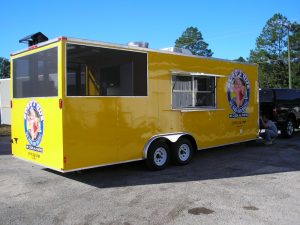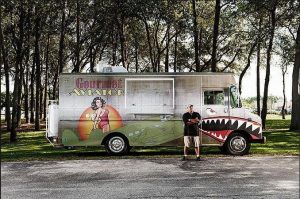It seems people are starting a food business almost every day. From jams and jellies, to prepared foods, salad dressings and of course food trucks. There’s a lot of options out there, but the reality is many of them won’t survive the first five years in business.
Some of them fail because they made critical mistakes in the very beginning. Here’s a list of eight things to watch out for if you’re thinking of starting a food business of any kind. These are some of the most common mistakes I’ve seen over the years.
1. Not testing your concept on a smaller scale
I’ve been talking with many start-up food entrepreneurs who are adamant about going big right out the gate. Don’t. Test your concept. Start with friends and family, move to a farmer’s market, and then start getting your product in retailers around town. Instead of starting with a full-scale restaurant, you could start building a brand with a small concession trailer or pop-up to prove there’s demand. By starting small, you’re able to prove your concept through test-marketing and not waste your precious cash or time.
Some experts suggest using surveys to get feedback about your food, but I’d go straight to offering free samples so consumers have a chance to try your food risk free. If they like it, they’ll make a purchase. If you struggle to get sales for food items after giving away a free sample you might have a problem with your product.
While collecting feedback on your recipe using a survey can be helpful, I’ve always found that the best way to test whether or not someone is willing to pay for your food item is to charge them a fair price for it. If you ask people to open up their wallets, you’ll quickly discover whether or not you have a viable business idea.

A concession trailer can help you test a concept on a smaller scale than a restaurant.
2. Producing without a license or permit
The health inspector is like the local sheriff when it comes to food production. And you don’t want to upset them! Why so important? Well, if you’re caught in violation, the health inspector can shut you down right then and there.
Make sure you call the health department to see if you need a license to produce food – especially if you’re thinking of producing food in your home. Licenses can cost anywhere from $50 – $500 and in some cases more. Make sure you budget for the cost, too.
3. Not knowing your product cost
Of any on this list, this is the most important. You have got to know how much it costs to produce your product. That means ingredients, packaging, and labor. (And even if you produce your product by yourself, there’s still a labor cost!). Your product cost drives your company’s profitability. If you’re not charging enough for your food product, you’re not going to be able to cover your operating costs. Want help? Get in touch with me (michael [at] gredio [dot] com) and I’ll lend a hand.
4. Running out of cash in the first few months
Cash is king in any business. You need to hang onto it like your company depends on it. Because it does. If you’re splurging on marketing you might not need or fancy labels, think about what that does to your product cost. Or, if you’re buying supplies left and right, have you thought about making them yourself? Oh, and not to mention cash for farmer’s markets and producing your product. Make sure you have enough to keep you going – even when it’s slow in the beginning.
5. Thinking you don’t need help
You want to build your food business to the point where it’s sustainable. You can put food on the table and a roof over your head. That would be awesome, right? The truth is you’re going to need help to get there.
Analyze your business. Identify what you don’t like to do. Then, find someone to do it for you. Yes, it costs money. But, what about avoiding burnout? You can’t possibly do everything for ever. For example, I have my parents help out with shows, scheduling, hotels, and other logistics. (That’s why my Mom’s job title is the Conductor of Controlled Chaos – it’s exactly what she does).
6. Underestimating the Importance of Marketing
One of the most common oversights for new food entrepreneurs is underestimating the power of a well-crafted marketing strategy. Marketing isn’t just about selling your product, it’s about telling a story that resonates with your customers, creating an identity that they can connect with, and building a reputation that encourages loyalty and referrals.
Branding is More Than Just a Logo
A strong brand identity starts with a compelling logo, but it encompasses much more. Your brand is the emotional and psychological relationship you have with your customers. Effective branding includes the design of your packaging, the tone of your communications, the style of your website, and even the uniforms your staff wear. Each element should reflect the values and appeal of your business.
Leveraging Social Media
Social media is a powerful tool for food businesses, not just for promotion but for creating communities around your products. Platforms like Instagram, Facebook, and Twitter allow you to showcase your offerings with high-quality images and engage directly with your customers through comments, polls, and direct messaging. Additionally, social media can be a feedback tool, giving you real-time insights into what your customers love and what could be improved.

Don’t overlook marketing!
Crafting Your Story
Every food business has a story. Perhaps your jam is based on a family recipe, or your restaurant focuses on locally sourced ingredients. These stories create emotional connections with customers, making them more likely to choose your product over a less personal option. Your marketing strategy should weave this narrative into every communication channel, from your website’s about page to the backstories of your menu items.
7. Ignoring Customer Experience
In the food industry, the customer experience can be just as important as the food itself. A positive dining experience can turn a first-time visitor into a regular customer, while a negative one can deter future visits and lead to poor online reviews. There are two key aspects to focus on: customer service and ambiance.
Importance of Customer Service
Customer service in the food business begins the moment a customer interacts with your brand, whether that’s through a phone call, an online order, or stepping into your establishment. Each interaction should leave a positive impression. Training your staff in customer service skills—such as effective communication, patience, problem-solving, and attentiveness—is crucial. They should be able to handle inquiries, complaints, and orders with professionalism and a friendly attitude. Remember, a smile can go a long way in making a customer feel welcomed and valued.
The Role of Ambiance
The ambiance of a dining establishment plays a significant role in shaping the customer experience. It’s not just about having a clean and attractive setting; it’s about creating an environment that enhances the dining experience and reflects the personality of your brand. This can include the choice of decor, lighting, music, and even the spacing between tables. For example, softer lighting and quiet, soothing music can make for a more intimate and relaxed dining experience, which is perfect for upscale restaurants. In contrast, a brighter, vibrant environment with energetic music might be more suitable for a casual dining spot or a café.
Ambiance also extends to the perceived cleanliness and safety of the environment, which has become even more important in recent times. Customers expect a clean, well-maintained space where they feel their health is not at risk.
Bonus! Not having product liability insurance
This is going to be a big start-up cost for you – several hundred of dollars (depending on the size of your operation, it could be in the thousands, too). This is necessary for many retailers and markets, so make sure you have it from the beginning. Don’t know the first thing about insurance? Here’s a post I wrote earlier this year on food product liability insurance.
Lots of people start food business. And lots of those businesses fail in the first five years. Make sure you have your jars in a raw and your labels on tight, because a food business can be a wild ride. What would you add to this list? Let me know by reaching out on social media.
